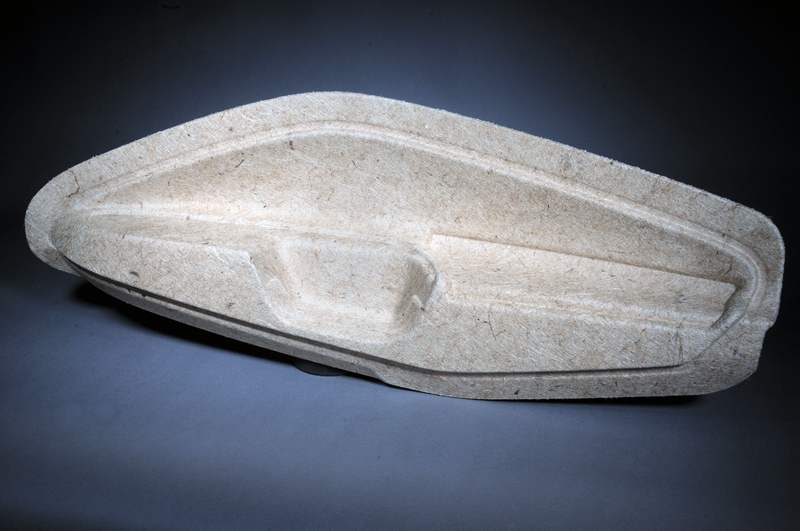 Benecke-Kaliko公司Xpreshn表面材料的触感非常柔软。
Benecke-Kaliko公司Xpreshn表面材料的触感非常柔软。  这种门板胎件(如图)采用了天然洋麻材料。IAC公司先使用粘合剂制成多层板,然后再将这种材料板组装成门板。由于粘合剂本身就是一种挥发性有机化合物,带有一定气味,因此公司也在研究真空形成的双层压板是如何通过粘合剂连接在一起的。
这种门板胎件(如图)采用了天然洋麻材料。IAC公司先使用粘合剂制成多层板,然后再将这种材料板组装成门板。由于粘合剂本身就是一种挥发性有机化合物,带有一定气味,因此公司也在研究真空形成的双层压板是如何通过粘合剂连接在一起的。 2016年沃德汽车内饰大会材料创新专家组成员,从左至右依次为FCA的Megan McConnell、Robert Eller Assoc.公司的塑料行业咨询师Robert Eller,以及Benecke-Kaliko公司的Dominik Beckman。
2016年沃德汽车内饰大会材料创新专家组成员,从左至右依次为FCA的Megan McConnell、Robert Eller Assoc.公司的塑料行业咨询师Robert Eller,以及Benecke-Kaliko公司的Dominik Beckman。
如今,车辆内饰材料创新对嗅觉、触觉、听觉和视觉等感官元素的关注,超过了以往任何时候。
中国购车者非常不喜欢某种新车的味道,而中国是全球最大的汽车市场之一。根据IHS Automotive的预测,到2020年,中国轻型乘用车的年销量预计将达到2900万美元。因此,消除那些中国用户痛恨的气味绝对“有利可图”。一般而言,这些气味通常来自特定的增塑剂或粘合剂。
在底特律举行的2016年沃德汽车内饰大会(2016 Wards Auto Interiors Conference)上,国际汽车零部件集团(International Automotive Components,简称IAC集团)高级开发与材料开发副总裁Rose Ann Ryntz博士在接受《汽车工程》记者采访时表示,“这种气味通常与挥发性有机化合物(VOC)材料有关,在某种程度上,中国市场将决定未来VOC材料的用量限制。”
大会期间,Ryntz博士在主持一轮材料创新讨论时表示,虽然所有OEM厂商不大可能采用完全相同的VOC规格标准,但有关有机化工材料使用的问题,已经提上了汽车行业的研究日程。
她说,“我们公司已经开始从传统的VOC搪塑PVC材料转型,正在寻找如何通过聚合型增塑剂,实现PVC或TPE材料的搪塑。我们也在同时研究真空形成的双层压板是如何通过粘合剂连接在一起的,因为粘合剂本身就是一种挥发性有机化合物,带有一定气味。”
触感柔软的Xpreshn材料
在沃德汽车大会上,3M公司发布了一系列低VOC粘合胶带。这些薄胶带经过专门设计,可用于扶手、中控台、仪表板、门垫等其他需要连接固定的汽车内饰应用。
德国汽车供应商,ContiTech集团旗下的Benecke-Kaliko公司市场营销与创新管理全球总监Dominik Beckman表示,最近该公司的Xpreshn低VOC表面材料产品线中新增了一款Xpreshn Lux材料,可以用于仪表板、车门饰件等各种驾舱内饰中的应用,触感非常柔软。
Beckman在谈及Xpreshn Lux时表示,“这种材料的漆面就像泡沫层一样,超级柔软。因此,采用这种材料的整个结构也将非常柔软,但这绝不仅仅是柔软的泡沫而已。”
公司的员工声称,Xpreshn Lux要比公司另一款用作表面材料的低密度聚烯烃薄膜Tepeo柔软五倍。据了解,Xpreshn Lux将率先登陆销往中国的凯迪拉克XTS车型。Beckman表示,“我们的Xpreshn Lux可以替代成本高昂的皮革材料,为车主提供一种超级奢华的触感。”
Xpreshn Lux是一种热成型材料。目前,另一版更加高级的Xpreshn材料已经进入研发的最后阶段。Beckman告诉《汽车工程》,这“将是一种可以直接‘剪切-缝纫’的TPO型材料,绝对与真空成型的传统工艺完全不同。”
降低NVH,提升美感
对车主而言,如果希望通过语音命令,控制导航和信息娱乐等各种车内通信系统,那么一个不受道路噪声、风噪与发动机噪声影响的安静车内环境就显得尤为重要。
塑料行业咨询师Robert Eller表示,“在我们尝试使用以石墨烯等其他碳材作为原材料的聚氨酯泡沫,从两面提高防火墙的声学性能时,获得了一些值得关注的发现。”
菲亚特克莱斯勒汽车美国产品设计办公室先进色彩与材料设计师Megan McConnell表示,“表面”复合材料可以让车辆的内饰看起来更有吸引力。他表示,“通过在设计中直接整体采用复合材料,从而免去表面材料的应用,我们可以降低车辆的重量、成本与复杂性。”
虽然法规、标准与客户偏好均会影响材料创新的走向,但成本仍是选择材料时最为关键的因素。
“如果你看看车辆座椅,你就应该知道现在的车辆座椅已经没有多少利润了。因此,很多一级供应商已经从这个领域撤出了。”Eller表示,“成本控制常常会阻碍创新,但有时也能促进创新。”
作者:Kami Buchholz
来源:SAE《汽车工程》杂志
翻译:SAE中国办公室
That 'new car smell' is forcing interior materials changes
The sensory elements of smell, touch, sound, and sight are influencing material innovations for vehicle interiors more than ever.
Chinese car buyers abhor certain new car smells. And with annual light-duty passenger vehicle sales in China projected to reach 29 million by 2020, according to forecasters IHS Automotive, there are clear financial reasons for ridding car and truck interiors of the objectionable odors associated with certain plasticizers and adhesives.
“That odor kind of goes hand-in-hand with VOC (Volatile Organic Compound) requirements, and China to a certain extent is going to lead how VOC limits are set,” Rose Ann Ryntz, Ph.D., Vice President of Advanced Development & Material Development at International Automotive Components (IAC), said in an interview with Automotive Engineering at the 2016 WardsAuto Interiors Conference in Detroit.
Although it’s unlikely that all OEMs will have the same VOC specification standards, organic chemicals are on the industry’s docket, said Ryntz, moderator of a materials innovation panel at the conference.
“We’re moving away from VOC-laden PVC slush [programs] at IAC, and we’re looking to do more with polymeric plasticizers for slush PVC as well as slush TPE-type [projects]. We’re also looking at how the construction of vacuum formed bi-laminates are put together with adhesives, since the adhesives can be a big source of VOC and odor,” she said.
A soft-touch Xpreshn
3M debuted a new line of low-VOC attachment tapes at the WardsAuto conference. These thin tapes are designed for armrests, center consoles, instrument panels, door bolsters, and other interior applications that require bonding and dimensional stability during lamination.
The recently launched Xpreshn Lux, a low VOC surface material in Benecke-Kaliko’s Xpreshn product line, gives a soft-touch sensation to instrument panels, door trims and other cabin locales, according to Dominik Beckman, the company’s Global Director of Marketing and Innovation Management. Benecke-Kaliko is part of theContiTech group.
“It has an ultra-soft lacquer coating, and the formulation is ultra-soft as is the foam layer. The whole construction is ultra-soft. It’s more than just a soft foam, Beckman said about Xpreshn Lux.
Company officials claim that Xpreshn Lux is up to 500% softer than Tepeo, Benecke-Kaliko’s low density polyolefin foil that is used in surface materials. Xpreshn Lux is marking its global debut on the Cadillac XTS sold in China. “Our Xpreshn Lux gives an ultra-luxury touch sensation as a lower-cost alternative to leather,” said Beckman.
Xpreshn Lux is thermoformed. An up-level Xpreshn version is in the final stages of development. It "will be cut-and-sew for a TPO-type of material, so that’s definitely different than the traditional processing method of vacuum-forming,” Beckman toldAutomotive Engineering.
Reducing NVH, raising aesthetics
An interior that’s not roaring with road, wind, and engine noise is especially desirable for drivers using voice commands for navigation, entertainment, and other in-vehicle communications.
According to plastics industry consultant Robert Eller, “There are some very interesting things happening with polyurethane foams using graphene and other forms of carbon to improve the acoustic performance on both sides of the firewall.”
An ‘exposed’ composite material could heighten a vehicle interior’s visual appeal, said Megan McConnell, Advanced Color and Materials Designer in Fiat Chrysler Automobiles U.S. Product Design Office. “By emphasizing [composites] as a design feature and eliminating the surface materials, we reduce weight, cost, and complexity,” McConnell said.
Although innovations are influenced by regulations, standards, and customer preferences, cost remains a crucial factor in materials selection.
“If you look at automotive seating, you can see that the profitability has been driven out. That’s why we see many of the tier one [suppliers] escaping that sector,” Eller said. “That’s something we like to look at as an impediment to innovations. Or sometimes, it’s a stimulant.”
Author: Kami Buchholz
Source: SAE Automotive Engineering Magazine
等级
打分
- 2分
- 4分
- 6分
- 8分
- 10分
平均分
- 作者:Kami Buchholz
- 行业:汽车
- 主题:材料
